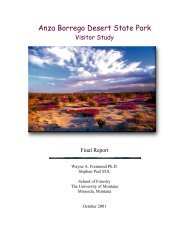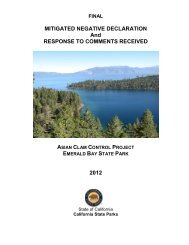Draft EIS/EIR for the San Luis Reservoir SRA Resource ...
Draft EIS/EIR for the San Luis Reservoir SRA Resource ...
Draft EIS/EIR for the San Luis Reservoir SRA Resource ...
You also want an ePaper? Increase the reach of your titles
YUMPU automatically turns print PDFs into web optimized ePapers that Google loves.
4. Plan Overview<br />
developing current and future management strategies. The key attributes are <strong>the</strong>n<br />
used to develop a single alphanumeric rating to describe <strong>the</strong> overall character of a<br />
water surface area. The rating system incorporates <strong>the</strong> water recreation<br />
opportunities abbreviations shown above (U, S, RD, RN, SP, and P) along with a<br />
number between 1 and 11, which correspond to <strong>the</strong> water recreation opportunities<br />
abbreviations as follows:<br />
Scale<br />
WROS Class<br />
1 – 2 Urban<br />
2 – 3 – 4 Suburban<br />
4 – 5 – 6 Rural Developed<br />
6 – 7 – 8 Rural Natural<br />
8 – 9 – 10 Semiprimitive<br />
10 – 11 Primitive<br />
The 11-point scale allows <strong>for</strong> a finer level of assessment than a six-point scale (U,<br />
S, RD, RN, SP, and P) and identifies areas where <strong>the</strong>re are transitions, gradations,<br />
or “leanings” toward one WROS class versus ano<strong>the</strong>r. The 11-point scale allows<br />
<strong>for</strong> a higher level of accuracy during <strong>the</strong> inventory stage and helps managers to<br />
consider alternative ways to manage <strong>the</strong> area in <strong>the</strong> future. In <strong>the</strong> Plan Area, <strong>the</strong><br />
numeric ratings indicate subtle distinctions among physical, social, and<br />
managerial attributes within different parts of <strong>the</strong> same waterbody, such as <strong>San</strong><br />
<strong>Luis</strong> <strong>Reservoir</strong> (see Map 8).<br />
The WROS designations were made based on site visits and inventories<br />
conducted during <strong>the</strong> planning period. Existing WROS conditions were<br />
characterized primarily during <strong>the</strong> development of <strong>the</strong> WROS Inventory and<br />
Management Alternatives report in 2003 and 2004 (Aukerman, Haas, and<br />
Schuster 2008). Conditions were reassessed and updated management zones were<br />
assigned by alternative during field visits by CSP, Reclamation, and consultant<br />
staff in May and June 2011.<br />
In addition to <strong>the</strong> WROS designations <strong>for</strong> water-based management zones, three<br />
additional designations have been assigned <strong>for</strong> land-based management zones.<br />
These zones reflect management areas that exist now (such as operations vs.<br />
recreation) and are intended to help focus future facilities and uses in appropriate<br />
areas. The land-based management zones are intended to “dovetail” appropriate<br />
facilities and uses with adjacent WROS zones. These management zones are <strong>the</strong><br />
same as those used in CSP’s General Plan <strong>for</strong> Pacheco State Park (CSP 2004).<br />
Sections 4.3.1 through 4.3.6 describe each management zone’s unique<br />
characteristics and <strong>the</strong> key existing features that are intended to be considered and<br />
incorporated into Plan implementation. Natural and cultural resources exist in all<br />
zones within <strong>the</strong> Plan Area and, as described below, will be protected and<br />
managed as part of <strong>the</strong> future development. For each management zone, <strong>the</strong><br />
definition includes <strong>the</strong> following description:<br />
4-32 <strong>San</strong> <strong>Luis</strong> <strong>Reservoir</strong> <strong>SRA</strong><br />
<strong>Draft</strong> RMP/GP and <strong>Draft</strong> <strong>EIS</strong>/<strong>EIR</strong>
















